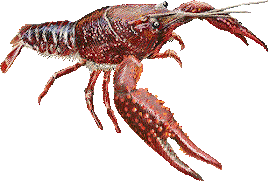Crawfish (or crayfish) have social,
economic and ecological significance
in several regions around the world,
including the southern United States.
Louisiana dominates the crawfish
industry of North America in both
aquaculture and wild capture fisheries.
Crawfish also are cultivated for
food in Texas, Arkansas, Mississippi,
Alabama, South Carolina and North
Carolina, and are consumed in these
and many other states. However,
there is no place where crawfish
have had more impact on the economy
of a region than in Louisiana,
where the industry contributes well
in excess of $150 million to the
state’s economy annually.
Species of importance
Procambarus clarkii (the red swamp
crawfish) and P. zonangulus (the
white river crawfish) are the species
of greatest commercial importance in
the southern U.S. Procambarus acutus
acutus, sometimes referred to as the
eastern white river crawfish, is cultivated
in several states along the east
coast of the U.S. and is nearly indistinguishable
from P. zonangulus.
These crawfishes belong to the phylum
Arthropoda (subphylum
Crustacea), order Decapoda, and
family Cambaridae. The red swamp
crawfish is native to the states bordering
the Gulf of Mexico from Texas
to Alabama, northward up the Mississippi
River drainage into Tennessee
and Illinois, and southward into eastern
Mexico. The red swamp crawfish
has been introduced in other areas of
the U.S. (including Hawaii) and in at
least 19 other countries in Central
and South America, the Caribbean,
Europe, Africa and Asia. The white
river crawfish is found in the southern
states along the Gulf of Mexico
and northward up the Mississippi
River drainage, possibly as far as the
confluence of the Mississippi and
Ohio Rivers. The eastern white river
crawfish is found along the Atlantic
coastal plain into southern New
England.
The red swamp and white river
crawfishes, and to a lesser extent the
eastern white river crawfish, have
similar ecological requirements. The
red swamp and white river crawfishes
often co-exist in the same native
habitat or managed impoundment.
Both are ecologically adapted to the
annual hydrological cycles of spring
flooding and summer dry periods
common to large river systems and
floodplains in the region. Both
species construct simple shallow burrows,
to which they retreat to reproduce
and survive temporary dry periods.
One notable difference between
the two species is that, in the South,
the white river crawfish is a seasonal
spawner, reproducing only in the fall
and winter. Red swamp crawfish may
spawn at any time during the year
when environmental conditions are
favorable. The red swamp crawfish
produces more, but smaller, eggs
than the white river crawfish. The
red swamp crawfish appears to be
better adapted to nutrient-rich waters
and may tolerate higher water temperatures,
although these differences
have not been confirmed. The white
river crawfish grows faster at cooler
temperatures and can attain a slightly
higher maximum size of about 130
grams (3.5 crawfish per pound).
Anecdotal evidence indicates that the
red swamp crawfish is usually more
abundant in standing water habitats
with low dissolved oxygen, such as
swamps. Hence the common name
red swamp crawfish.
Both red swamp and white river
crawfishes do well in commercial
crawfish ponds, and both thrive in
the low-energy-input, extensive aquaculture
systems used in Louisiana
and other southern states. Though
the abundance of each species can
vary among ponds and within a pond
during the 7- to 10-month production
cycle, the red swamp crawfish most
often dominates the catch and is the
most desired species in the marketplace,
particularly in Louisiana.
White river crawfish are usually
most numerous in ponds that have
been in continuous cultivation for
several years; it occasionally becomes
the dominant species over time.
The factors that govern the relative
abundance of the two species in
production ponds are not fully
understood. Research has shown
that the species that enters the
Monday, September 14, 2009
Subscribe to:
Post Comments (Atom)





No comments:
Post a Comment